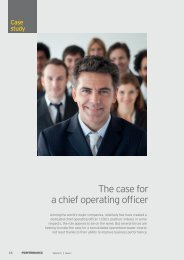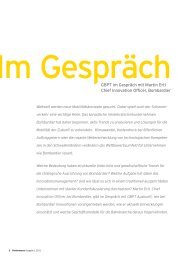PERF RMANCE 04 - The Performance Portal - Ernst & Young
PERF RMANCE 04 - The Performance Portal - Ernst & Young
PERF RMANCE 04 - The Performance Portal - Ernst & Young
Create successful ePaper yourself
Turn your PDF publications into a flip-book with our unique Google optimized e-Paper software.
Measuring corporate sustainability<br />
Figure 1. Procedure for calculating SVA<br />
Changes in usages of resources compared<br />
to previous period<br />
Opportunity cost of increased or decreased<br />
consumption of resources<br />
Average of opportunity cost<br />
of all resources<br />
Average and economic growth<br />
Result: Sustainable Value Added<br />
Source: According to Figge & Hahn, 20<strong>04</strong>b, p.132<br />
We will now look at the formula for<br />
calculating the sustainable value in a little<br />
more detail, as this will be the starting point<br />
for further examination in this article<br />
(Ang & Van Passel, 2010, p. 1):<br />
SV = 1 R y<br />
∑<br />
i R r x<br />
i<br />
ir<br />
y<br />
x r<br />
x<br />
Where:<br />
SV i = Sustainable Value of companyi<br />
R = Total amount of resources considered<br />
y i = Economic output of companyi<br />
y = Economic output of benchmark<br />
x ir = Resource of companyi<br />
= Resource of benchmark<br />
x r<br />
ir<br />
First of all, the economic output of<br />
〖company〗i is determined in relation to its<br />
use of a particular resource Xir. This is<br />
then compared to the benchmark which<br />
gives the relevant opportunity costs. <strong>The</strong><br />
benchmark’s factor is then subtracted<br />
from the company’s factor resulting in<br />
the value spread. <strong>The</strong> value contribution<br />
of a resource, which 〖company〗i uses, is<br />
calculated by multiplying the value spread<br />
by the amount of the resource. To avoid<br />
double counting, after adding up all value<br />
contributions, the figure is divided by the<br />
total amount of resources considered.<br />
This calculation measures a company’s<br />
sustainable value for just one period and<br />
so in order to develop a more dynamic<br />
process, the sustainable value for two<br />
periods needs to be calculated. This is<br />
arrived at as follows:<br />
〖SVA〗i,t0 =〖 EG〗i,t0 — (〖SV〗i,t1— 〖SV〗i,t0)<br />
Where:<br />
〖EG〗i,t0 = Economic growth of 〖company〗i in<br />
〖period〗t0<br />
<strong>The</strong> sustainable value of 〖period〗t1 and 〖<br />
period〗t0 are subtracted to obtain the<br />
change in use of resources of 〖company〗i.<br />
As 〖period〗t0 is the period we are looking at,<br />
this figure is deducted from the economic<br />
growth in 〖period〗t1. <strong>The</strong> result is the relative<br />
SVA of 〖company〗i in 〖period〗t0 representing<br />
the change in use of a set of resources<br />
which has contributed to an increase in<br />
sustainable value.<br />
Links with Economic Value<br />
Added<br />
If we now consider the Shareholder Value<br />
Approach, its main purpose is in long-term<br />
shareholder wealth maximization. This is<br />
particularly true for medium-sized firms<br />
which view increased shareholder value<br />
as essential to a company’s success. In<br />
order to operationalize and implement<br />
the Shareholder Value Approach, there<br />
are a few indices of measurement but it is<br />
the Economic Value Added (EVA) method<br />
which is one of the most applied indices<br />
when it comes to putting the Shareholder<br />
Value Approach into practice. <strong>The</strong> EVA<br />
approach is the prevalent concept and has<br />
a multitude of benefits compared to other<br />
approaches (Kunz et al., 2007). A survey<br />
with 186 major US enterprises which<br />
was performed in 1999 concluded that a<br />
majority of 87% was already familiar with<br />
value-based management. <strong>The</strong> value-based<br />
accounting concept EVA achieved 94% and<br />
was therefore by far the most well-known<br />
concept (Ryan & Trahan, 1999, p. 49).<br />
<strong>The</strong> EVA is given after deduction of all<br />
interest on net operating capital. In other<br />
words, the EVA comprises the profit for a<br />
period after subtracting all capital costs.<br />
A positive value means there are residual<br />
earnings or excess profits. Typically, the<br />
formula comprises:<br />
E = NOPAT – (Invested capital × WACC)<br />
Where:<br />
NOPAT = Net operating cash profits of the<br />
company after taxes but before any interest<br />
expenditure<br />
Capital invested = Economic capital<br />
invested in the business includes both<br />
equity and debt but does not include noninterest<br />
bearing current liabilities<br />
WACC =Weighted average cost of capital 1<br />
1 For the calculation of WACC see Faupel et al. 2010, p. 57.<br />
33






